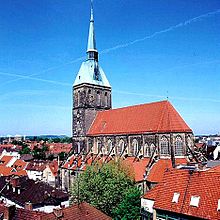St. Andreas, Hildesheim
| St. Andrew's | |
|---|---|
| Church of St. Andrew's | |
|
|

St. Andrew's, amidst the urban roofscape
|
|
| 52°09′06″N 09°57′00″E / 52.15167°N 9.95000°ECoordinates: 52°09′06″N 09°57′00″E / 52.15167°N 9.95000°E | |
| Location | Hildesheim |
| Country | Germany |
| Denomination | Lutheran |
| Website | www |
| History | |
| Dedication | |
| Architecture | |
| Status | parish church |
| Functional status | active |
| Architectural type | hall church |
| Style | Gothic |
| Groundbreaking | late 14th century |
| Completed | 1504 1883 (tower) |
| Specifications | |
| Length | 80 metres (260 ft) |
| Width | 35 metres (115 ft) |
| Nave height | 27 metres (89 ft) |
| Spire height | 114.5 metres (376 ft) |
| Bells | 4 (4) |
| Administration | |
| Parish | St.-Andreas-Gemeinde, Hildesheim |
| Deanery | Hildesheim-Sarstedt (Kirchenkreis) |
| Synod | Church of Hanover |
The church of St. Andreas is the principal Lutheran church of Hildesheim, Germany, not to be confounded with the Catholic Hildesheim Cathedral. Its tower is 114.5 metres (376 ft) tall, making it the tallest church tower in Lower Saxony; it is accessible (364 steps) and offers a panoramic view of both the city and surrounding countryside.
The earliest church building on the Treibeinsel dedicated to the Apostle Andreas (Andrew) was a simple pre-Romanesque chapel, which already existed at the death of Bishop Bernward in 1022. Bishop Godehard was brought here after his death in 1038 so the people could mourn.
During the romanesque period, the center of the market and workshops was relocated from the swampy lowlands between Domburg and Michaeliskriche ("Old Market") to near St. Andreas. The chapel was subsequently replaced with a romanesque church with a strong westwork.
The building of the gothic church, in the basilica style and romanesque westwork, was begun at the end of the fourteenth century, the choir in 1389, the northern nave in 1404, and the tower in 1503. By 1504, the nave with its side altars was finished and all that remained to be completed was the tower. This was only done in 1883-1890, when the tower reached its current height. The interior, with the quire and the radiating side chapels to the east, was modeled after the French cathedrals.
Like market churches in many other German dioceses, St. Andreas represented bourgeois self-confidence in the High Middle Ages in comparison to the lordship of the Bishops, manifested in the cathedral. During the Reformation, this old question of authority was combined with the religious question. Consequently, in 1542, St. Andreas became the first church in Hildesheim to support Lutheranism; it was also there where Johannes Bugenhagen initiated the new church order. This is remembered in the 1995 Brunnen Memorial by Ulrich Henn, which is located in the southern of forecourt the church.
...
Wikipedia

